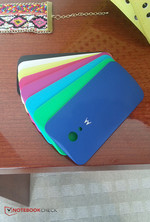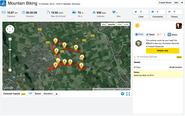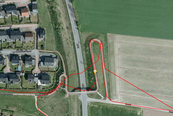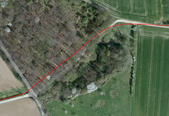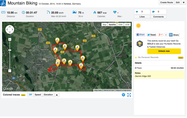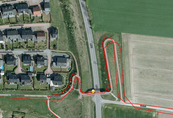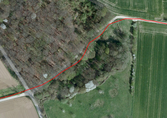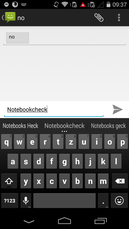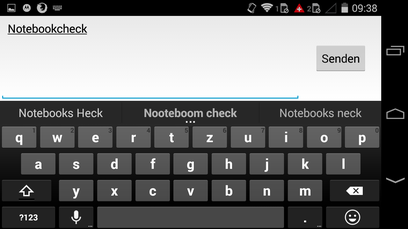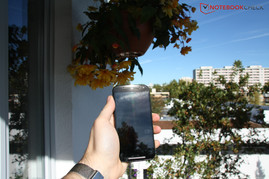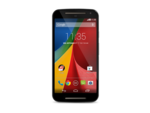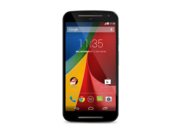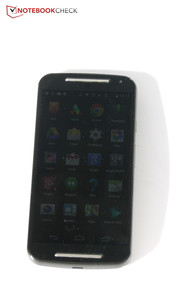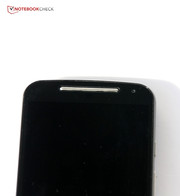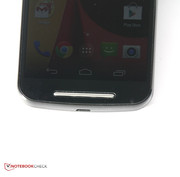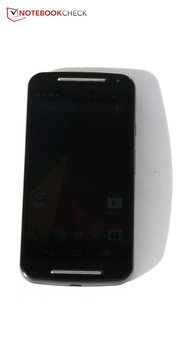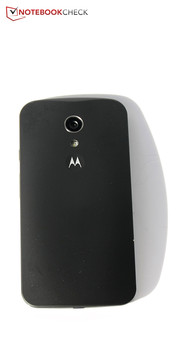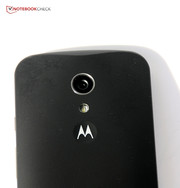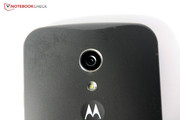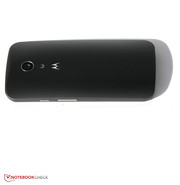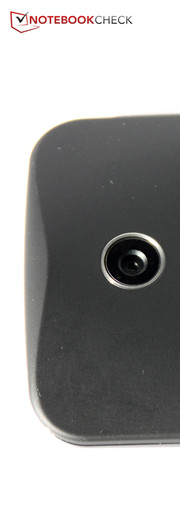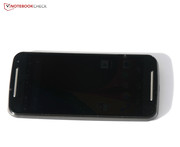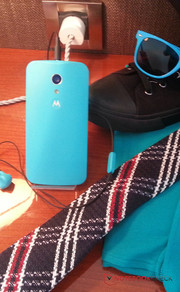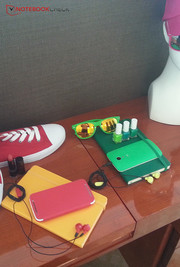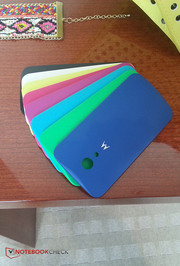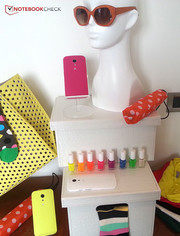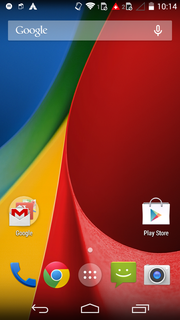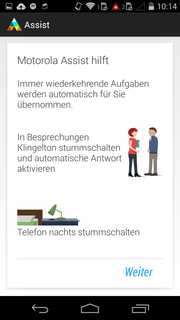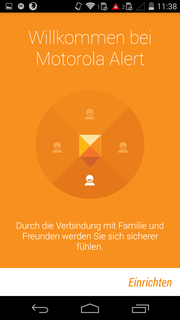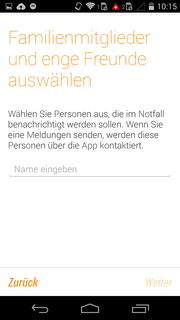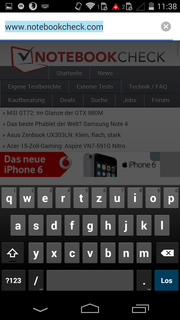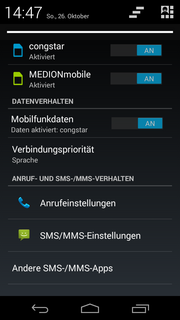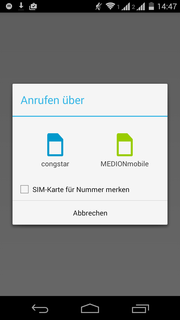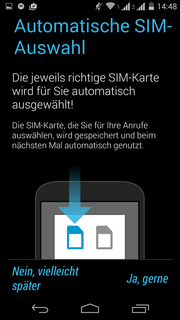Motorola Moto G2 Smartphone Review

For the original German review, see here.
"Something has got bigger" might be the first thought if you know the Motorola Moto G of 2013. Its successor is now available in stores and on the Internet, and is actually significantly larger: The display size was increased from 4.5 to 5 inches. You also get a higher-resolution camera and stereo speakers at the front. Otherwise, there are many similarities, for example, the SoC or the display resolution. Are the small changes sufficient to justify the increased RRP to 199 Euros (~$248)?
To check this, we will compare the second generation Motorola Moto G with its predecessor Motorola Moto G as well as the following smartphones: LG L Bello, HTC Desire 510, Nokia Lumia 630, Alcatel One Touch Pop C7, Huawei Ascend G610, Acer Liquid E700 Trio, and Samsung Galaxy Ace 4. A comparison with the Google Nexus 5, which is still available, is also interesting – how much smartphone do you get for 150 Euros (~$187) more?
Case
The Motorola Moto G2 is basically available in the colors black and white. If you are familiar with Motorola, and know that the new Moto X can be customized with dozens of materials like wood, leather and colored elements, you will probably expect the same from the Moto G. The back cover of the smartphone can be removed and replaced with colored covers. More information is available in the Accessories section. However, it remains Motorola’s secret as to why, unlike the Samsung smartphones, it is so hard to remove the back cover and replace the battery.
Motorola has not changed the design. The second generation of the Moto G is once again simple, and has a curved back with a depressed logo that is a good resting point for the index finger. The speakers are now at the top and bottom of the display, otherwise the two generations of the Moto G are very similar, except for the size of course. The Moto G2 is also slightly slimmer than before with 11 millimeters (~0.4 inches). According to Motorola, the case is also protected against small amounts of rain or spill-water thanks to its compact construction and despite the detachable back cover. However, there is no IP certification, so it might be a good idea to keep the smartphone away from water.
We cannot twist the chassis, but medium force on the display screen results in distortions. Pressure on the back, however, is no problem for the case.
Connectivity
So far, the second generation of the Motorola Moto G is only available with 8 GB internal storage. On the other hand, the Moto G now supports two SIM cards and also has a SD card reader, which, according to Motorola only supports SD cards up to 32 GB. Still, this is an improvement since you could not expand the storage of its predecessor at all. Apps can be copied to the SD card later on.
Nothing has really changed in terms of ports: Micro USB 2.0 and 3.5 mm stereo jack are available.
Software
The operating system of the Moto G2 is Android 4.4, so the Motorola is up to date. Furthermore, it is the so-called Vanilla version, which means Google provides the operating system, and Motorola has not installed its own user interface. One advantage of this solution is that Android updates are quickly available on the Moto G since they do not require any adjustments from Motorola. According to the manufacturer there will be at least one more update for the OS. It will probably be the upcoming Android 5.0 Lollipop, but so far there has been no confirmation from the manufacturer.
Fortunately, no advertisements are preinstalled, but then, there are actually not many software additions offered either. Motorola has installed a tool for data migration, and emergency software that informs certain contacts in case of an emergency.
Communication & GPS
The Motorola Moto G is available with LTE, but the second generation has to manage without it: The fastest standard for the Internet on the road that is supported by the Moto G2 is HSPA+ with a maximum downstream of 21.1 Mbps. Four GSM and four UMTS bands should be sufficient to get a signal in many countries. Bluetooth 4.0 is available, but there are no other connectivity options like NFC.
You can equip the Moto G2 with one or two micro SIM cards, since the smartphone supports the simultaneous use of two SIM cards. This means you can, for example, combine your business contacts and a private smartphone on one device or use a cheaper provider for the data plan while you use the other SIM card to make phone calls. The signal quality was good in the German Telekom and E-Plus networks, and we usually had a full signal in the metropolitan area.
The SIM management in Android works well. There are many convenient features, for example, the automatic selection of the SIM card after you chose a card for calls. In some menus, you can store individual settings for each SIM card, and you can obviously activate or deactivate the cards individually.
Apart from the mobile Internet, you can establish connections to wireless networks, according to the standards 802.11 b/g/n. The new and fast 802.11 ac standard is missing, but the speed is decent nonetheless. And the signal quality of the Moto G2 is very good: We still had the full signal with a distance of ten meters (~33 ft) from the router and through three walls, it only dropped to 3/4 occasionally. Another two meters (~6.5 ft) and another wall, result in 3/4 of the signal – very good.
The GPS module also supports the Russian GLONASS network. Locating the position indoors is not possible: The smartphone finds some satellites, but the signal is not strong enough to locate our position. It also takes a while outdoors, however, the location is very accurate: The smartphone locates our position down to three meters (~9.8 ft).
We use the Motorola Moto G2 on a bicycle ride for a more extensive test, and compare it with our reference device, the professional navigation device Garmin Edge 500. The resulting track lengths of the two devices are actually different: A deviation of around 300 meters (~984 ft) on an 11 kilometers (~6.8 mi) long track. The bridge crossing shows that the Moto G2 does not always get the correct position, but it seems we are "flying" across the road instead of showing the correct position on the bridge. All in all, the GPS module of the Moto G could be better, but it is still okay for the occasional navigation.
Telephone Functions and Voice Quality
Due to the unmodified Android version, you also get the original Google phone app. The keys could be better separated from each other, but otherwise there is no cause for criticism: You get contact recommendations when you enter a number or a name. You can create favorites, use voice inputs, and there is obviously a list with incoming and outgoing calls.
The voice quality is okay when you actually make a call, but it is not as clear as the Sony Xperia Z3, for example, that we reviewed recently. The other person sounds a bit muffled and also complains about the inadequate noise filtering of the microphone. You hear the other person clearly via speaker, and the volume is good . Overall, the quality of calls is decent with the Motorola Moto G2, but you should not expect a great sound quality that you get from some higher-quality smartphones.
Cameras & Multimedia
Motorola has improved the cameras, both have a higher resolution now. You can take pictures with 2.0 megapixels in the front, and up to 8 megapixels in the back. The aperture at the back is also slightly larger now with f/2.0, so there should be small improvements under bad lighting conditions. Our sample pictures actually show that the sensor captures more light than the iPhone 6 with an aperture of f/2.2, for instance. However, bright areas also outshine in bright pictures as a result. The Apple iPhone 6 manages better results in this scenario.
The Moto G2 cannot compete with the excellent cameras of the Nokia Lumia 1020, or the iPhone 6 in terms of details or depth of field: Details like the laurel bush in scene 3, are much sharper in the pictures of the two rivals. The Moto G2 cannot quite keep up in terms of color reproduction, but darker areas are actually brighter compared to its rivals. The HDR mode improves the illumination of dark areas as well, we activated it in scene 2. All in all, the pictures of the Motorola Moto G2 are quite decent if you do not get into the details. The quality is more than adequate for social media or small prints, especially since you can manually adjust the exposure and focus, which allows more control over the picture compared to the rivals. Another new feature is that you can now take pictures when you press the volume rocker.
The front camera is a clear improvement over its predecessor, so it can be used for selfies. However, you should not look at the pictures too closely since the sharpness is not really good in the details.
Videos can be recorded with up to 720p, and only with 30 frames per second. This is sufficient for a smooth picture, but the movements are better with 50 or 60 fps. The video quality of the Moto G2 is decent in general, but it could have been due to the Full HD resolution. The Acer Liquid E700 Trio, for example, offers this resolution. The Moto G2 has a mode for slow-motion videos, but they are just 60 frames videos that are played with 15 frames per second, so the quality is not very good.
Accessories
The box contains only a USB cable, but Motorola does not include a power adaptor. You can at least charge the smartphone at a PC if you do not have a module at home. Otherwise, there are inexpensive USB power adaptors on the Internet or in retail stores. However, it is rather disappointing, especially for first-time buyers, and there is just a small note on the box.
The most important optional accessories are the colored interchangeable covers: They are available in white, black, green, violet, pink, blue, turquoise and yellow. Motorola charges 12.99 Euros (~$16) for a cover. A Flipcover for the front is available in multiple colors as well for 29.99 Euros (~$37).
Warranty
Motorola offers a 24-month warranty for the smartphone.
Input Devices & Handling
Motorola has not changed the standard Android keyboard, either. It was not really necessary: The keyboard has a simple layout, is not crowded, and has sufficiently sized keys that are easy to operate. However, apart from voice inputs, there are no additional input methods like swiping over the keyboard or handwritten inputs. This can obviously quickly be fixed with solutions from the Play Store. The on-screen keyboard occupies around half of the screen in landscape mode.
The capacitive touchscreen can recognize up to ten inputs simultaneously and has no problems with multi-touch gestures. The gliding capabilities of the surface are good, and the touchscreen is precise up into the peripheral areas.
Display
The 5.0-inch display of the current Moto G has 1280x720 pixels. This means it is a 16:9 display and the resolution has not changed compared to the old Moto G. However, the display size is increased by 0.5 inches (~12.7 mm), so the Moto G2 has a slightly lower pixel density. This is not a big problem, since the picture is pretty sharp and the comparison devices either have the same or a lower resolution. If you do not want to forgo a Full HD display, you can get the Google Nexus 5, even though it costs 150 Euros (~$187) more. However, you get a display that is superior in other categories as well, as we shall see.
First, we look at the brightness, and the Motorola Moto G2 reaches 348.2 cd/m² on average. The review sample clearly has a disadvantage compared to the first generation Moto G, and the other comparison devices. The Moto G2 does at least have a very even brightness distribution of 96%, so large colored surfaces look very uniform on the screen.
| |||||||||||||||||||||||||
Brightness Distribution: 96 %
Center on Battery: 349 cd/m²
Contrast: 873:1 (Black: 0.4 cd/m²)
ΔE Color 3.74 | 0.5-29.43 Ø5
ΔE Greyscale 4.52 | 0.57-98 Ø5.3
Gamma: 2.63
| Motorola Moto G 2. Gen XT1068 Adreno 305, 400 MSM8226, 8 GB SSD | Motorola Moto G 1. Gen XT1032 Adreno 305, 400 MSM8226, 8 GB SSD | HTC Desire 510 Adreno 306, 410 MSM8916, 8 GB SSD | Alcatel One Touch Pop C7 Mali-400 MP2, MT6582M, 4 GB Flash | Nokia Lumia 630 Adreno 305, 400 MSM8226, 8 GB eMMC Flash | Google Nexus 5 Adreno 330, 800 MSM8974, 16 GB iNAND Flash | |
|---|---|---|---|---|---|---|
| Screen | -10% | -63% | -43% | -35% | 23% | |
| Brightness middle | 349 | 441 26% | 355 2% | 351 1% | 355 2% | 469 34% |
| Brightness | 348 | 417 20% | 371 7% | 329 -5% | 350 1% | 452 30% |
| Brightness Distribution | 96 | 89 -7% | 80 -17% | 88 -8% | 91 -5% | 94 -2% |
| Black Level * | 0.4 | 0.54 -35% | 0.37 7% | 0.44 -10% | 0.73 -83% | 0.49 -23% |
| Contrast | 873 | 817 -6% | 959 10% | 798 -9% | 486 -44% | 957 10% |
| Colorchecker dE 2000 * | 3.74 | 4.83 -29% | 12.13 -224% | 9.86 -164% | 7.19 -92% | 2.05 45% |
| Greyscale dE 2000 * | 4.52 | 6.2 -37% | 14.77 -227% | 9.33 -106% | 5.63 -25% | 1.45 68% |
| Gamma | 2.63 84% | 2.6 85% | 2.42 91% | 2.19 100% | 1.97 112% | 2 110% |
| CCT | 7336 89% | 8364 78% | 17097 38% | 10114 64% | 6293 103% | 6441 101% |
* ... smaller is better
We have already mentioned that the picture is pretty sharp, even at close range, but the difference compared to the Full HD resolution is actually visible, especially on a 5-inch screen. The colors appear restrained, and not as saturated as the AMOLED display of the Samsung Galaxy Ace 4, for example. The black value of 0.4 cd/m² is actually a good result for the Moto G2, and results in a contrast ratio of 873:1. The results are average within our comparison.
We use the software CalMAN, and a special measurement tool for a further color analysis. It shows that some of the colors are much more accurate than on the displays of many other rivals – at least with the sRGB color space as a reference. The average color deviation is pretty low with 3.74. The grayscale reveals a slight blue cast, which could cause the somewhat cool color representation.
The lower display brightness is a problem in very bright environments: The panel usually cannot compensate the very glossy display, and as a result, the content is not visible anymore. However, the situation is much better in the semi-shaded environments, and there are no problems in the shade or indoors. The automatic brightness sensor reacts pretty quickly and reliably to changing lighting conditions.
Thanks to the IPS panel, there is no cause for criticism of the viewing angles. They are very good in every direction, and the content is still visible from very flat angles. The only drawback: There is a white haze when you look from the left or right in portrait mode. This does not really affect the visibility, but the picture quality.
Performance
Compared to its predecessor, the core of the Motorola Moto G2 has not changed: It still uses the Qualcomm Snapdragon 400 MSM8226 with four cores clocked at 1.2 GHz, which is supported by 1,024 MB memory. As a result, the scores in the synthetic benchmarks are similar, and the same applies for the three comparison devices LG L Bello, Acer Liquid E700 Trio, and the Alcatel OneTouch Pop C7. Both the HTC Desire 510 and the Samsung Galaxy Ace 4 are much faster, just as the more expensive Google Nexus 5.
However, the performance of the Motorola Moto G2 should be sufficient for the majority of apps in practice – at least we did not notice any delays during our review.
| AnTuTu v5 - Total Score (sort by value) | |
| Motorola Moto G 2. Gen XT1068 | |
| HTC Desire 510 | |
| Google Nexus 5 | |
| Samsung Galaxy Ace 4 SM-G357FZ | |
| ANDEBench PRO - Device Score (sort by value) | |
| Motorola Moto G 2. Gen XT1068 | |
| Acer Liquid E700 Trio | |
| Quadrant Standard Edition 2.0 - --- (sort by value) | |
| Motorola Moto G 2. Gen XT1068 | |
| HTC Desire 510 | |
| Google Nexus 5 | |
Because of the identical SoC, the graphics solution of the Motorola Moto G2 has not changed either: An Adreno 305, which should be fast enough for the 720p resolution of the review unit. The battery test GFXBench 3.0 also shows that the device is able to maintain its performance, even under continuous load: The frame rates after 30 runs are just as high as after a single run.
The Moto G2 actually does not have to hide behind the comparison devices, only the Google Nexus 5 has a much more powerful GPU.
| GFXBench 3.0 - on screen Manhattan Onscreen OGL (sort by value) | |
| Motorola Moto G 2. Gen XT1068 | |
| HTC Desire 510 | |
| Acer Liquid E700 Trio | |
| Samsung Galaxy Ace 4 SM-G357FZ | |
| 3DMark | |
| 1280x720 offscreen Ice Storm Unlimited Score (sort by value) | |
| Motorola Moto G 2. Gen XT1068 | |
| Motorola Moto G 1. Gen XT1032 | |
| HTC Desire 510 | |
| Google Nexus 5 | |
| Huawei Ascend G610 | |
| Acer Liquid E700 Trio | |
| Samsung Galaxy Ace 4 SM-G357FZ | |
| LG L Bello | |
| 1280x720 offscreen Ice Storm Unlimited Graphics Score (sort by value) | |
| Motorola Moto G 2. Gen XT1068 | |
| Motorola Moto G 1. Gen XT1032 | |
| HTC Desire 510 | |
| Google Nexus 5 | |
| Huawei Ascend G610 | |
| Acer Liquid E700 Trio | |
| Samsung Galaxy Ace 4 SM-G357FZ | |
| LG L Bello | |
| 1280x720 offscreen Ice Storm Unlimited Physics (sort by value) | |
| Motorola Moto G 2. Gen XT1068 | |
| Motorola Moto G 1. Gen XT1032 | |
| HTC Desire 510 | |
| Google Nexus 5 | |
| Huawei Ascend G610 | |
| Acer Liquid E700 Trio | |
| Samsung Galaxy Ace 4 SM-G357FZ | |
| LG L Bello | |
| Basemark X 1.1 - Medium Quality (sort by value) | |
| Motorola Moto G 2. Gen XT1068 | |
| HTC Desire 510 | |
| Google Nexus 5 | |
| Acer Liquid E700 Trio | |
| Anomaly 2 Benchmark | |
| Low Quality Test (sort by value) | |
| Motorola Moto G 2. Gen XT1068 | |
| HTC Desire 510 | |
| High Quality Test (sort by value) | |
| Motorola Moto G 2. Gen XT1068 | |
| HTC Desire 510 | |
Everyday web browsing is very fast on the Moto G2, and it can keep up with the comparison devices, without overtaking them. The Google Nexus 5 once again shows that it is more powerful compared to the other devices in this category.
| Peacekeeper - --- (sort by value) | |
| Motorola Moto G 2. Gen XT1068 | |
| Motorola Moto G 1. Gen XT1032 | |
| HTC Desire 510 | |
| Google Nexus 5 | |
| Huawei Ascend G610 | |
| Acer Liquid E700 Trio | |
| Google V8 Ver. 7 - Google V8 Ver. 7 Score (sort by value) | |
| Motorola Moto G 1. Gen XT1032 | |
| HTC Desire 510 | |
| Google Nexus 5 | |
| Samsung Galaxy Ace 4 SM-G357FZ | |
* ... smaller is better
The writing performance of the internal storage is much better than the reading performance in the case of the Motorola Moto G2: The reading speeds are much lower than the rivals, the writing speeds, on the other hand clearly surpass the comparison devices and the random write speed even beats the Google Nexus 5.
Gaming Performance
Motorola advertises a great gaming experience without interruptions, even with demanding titles. We want to check this statement, and test GPU-demanding games like "Asphalt 8: Airborne" and the experience is actually smooth because of the low display resolution, but it does not look as sharp as a Full HD display. The latter would also be too demanding for the smartphone, which is apparent when you look at the "Offscreen" modes of the synthetic benchmarks, where we sometimes got the message that the memory was too low. The fact that we could not take any screenshots of the game is another indicator of a system at its limits.
The situation was better with "Batman: Arkham Origins", even though we noticed some dropped frames in the menus. However, the performance is usually adequate for complex titles on the 720p display of the smartphone. In addition the sensors executed inputs very reliably.
Emissions
Temperature
The Motorola Moto G2 uses the SoC from its predecessor, so you would expect a similar temperature development, right? The warming is actually on a par, and almost identical when you consider the different ambient temperatures. However, the brightness distribution across the case changed with the highest temperature of the Moto G2 at the front in the area of the lower speaker (in portrait mode) and the upper left side on the back.
Overall, the temperatures are very low with an absolute maximum value of 35.4 °C (~95.7 °F), which is noticeable, but not too warm. The temperatures are lower when idling, and hardly perceptible.
(+) The maximum temperature on the upper side is 35.4 °C / 96 F, compared to the average of 35 °C / 95 F, ranging from 21.9 to 56 °C for the class Smartphone.
(+) The bottom heats up to a maximum of 34.2 °C / 94 F, compared to the average of 33.8 °C / 93 F
(+) In idle usage, the average temperature for the upper side is 27.6 °C / 82 F, compared to the device average of 32.7 °C / 91 F.
Speakers
Motorola wants to improve the sound of the Moto G2. The speakers of the old Moto G were actually decent, but they were located at the back, so the sound changed depending on the surface. The Moto G2 on the other hand, has two speakers at the front, which reminds us of the HTC One M8 and Sony Xperia Z3. The current Moto G cannot compete with the big role models, but the quality is pretty respectable.
You get a very clear sound with a decent maximum volume. Listening to Adele’s "Skyfall" the piano at the start is very clear and detailed, and the voice sounds good as well. However, the speakers tend to distort with higher volumes as soon as the sound gets richer. These distortions are reduced when you turn down the volume, but you still have the feeling that the speakers hit their limit with rich sounds and the overall quality suffers slightly.
The balance between high and medium tones is nice, but the bass is not really available, as it is often the case. All in all the sound is quite decent, especially in this price range. Attaching headphones or external speakers results in a clear sound without distortions. You can even use the integrated FM-radio with headphones.
Energy Management
Power Consumption
The same SoC, but a bigger display – the Power Consumption section is certainly an interesting topic for the Motorola Moto G2, especially since the battery capacity has not changed compared to its predecessor. The idle consumption of the Moto G2 is actually just 0.2 Watts higher than its predecessor, but that is still up to 50% more than the first Moto G.
The second generation of the Moto G consumes less power than its predecessor under load at first. One reason may be the lower maximum brightness of the panel compared to the old Moto G. The maximum consumption of the Moto G2 on the other hand, is higher than the predecessor with 3.5 Watts vs. 2.8 Watts.
However, compare the results with the rivals, and you can see a completely different picture: The Motorola Moto G2 consumes much less power than other devices in this category.
| Off / Standby | |
| Idle | |
| Load |
|
Battery Runtime
Higher consumption, similarly sized battery – this obviously affects the battery runtimes, and they cannot quite keep up with the results of the first Motorola Moto G. Still, the Moto G2 once again manages pretty impressive battery runtimes, which should be sufficient for a whole day with mixed workloads. Devices like the HTC Desire 510 or the Nokia Lumia 630, for instance, are clearly left behind in the realistic WLAN test: Our review unit lasted for more than 15 hours. If you use a frugal video player, for example, you can easily manage a long train ride with HD videos without recharging the battery.
Compared to its predecessor, you loose between 3 and 10% battery runtime. Obviously we would have liked to see Motorola increase the capacity of the 7.9 Wh battery for the Moto G2, but we cannot really argue with the good results.
| Motorola Moto G 2. Gen XT1068 Adreno 305, 400 MSM8226, 8 GB SSD | Motorola Moto G 1. Gen XT1032 Adreno 305, 400 MSM8226, 8 GB SSD | HTC Desire 510 Adreno 306, 410 MSM8916, 8 GB SSD | Google Nexus 5 Adreno 330, 800 MSM8974, 16 GB iNAND Flash | Nokia Lumia 630 Adreno 305, 400 MSM8226, 8 GB eMMC Flash | Acer Liquid E700 Trio Mali-400 MP2, MT6582, 16 GB eMMC Flash | |
|---|---|---|---|---|---|---|
| Battery Runtime | 7% | -9% | -17% | -13% | 2% | |
| H.264 | 941 | 736 -22% | ||||
| WiFi | 904 | 930 3% | 570 -37% | 734 -19% | 874 -3% | 510 -44% |
| Load | 221 | 244 10% | 262 19% | 188 -15% | 187 -15% | 327 48% |
Verdict
Motorola continues its strategy with the Moto G2 and once again builds a simple smartphone with original Android and replaceable covers. The Moto G2 is not a device that is going to be very exciting, it is more of a loyal companion that hardly disappoints you.
It is nice that Motorola really improved the second generation of the Moto G: The front facing speakers are still not excellent, but at least decent. The cameras are significantly better too, but there is still room for improvement, for example the video resolution. The Moto G2 supports two SIM cards ex-works, which is a nice feature. The system performance is not outstanding since Motorola still uses the SoC from the predecessor, but the gaming performance is still decent.
Real points of criticism are the missing power adaptor, the pressure-sensitive chassis, and the slow GPS module. You might also wonder about the firm replaceable back cover, and why the battery capacity is not larger than before.
Overall, the second generation of the Motorola Moto G is a very successful update, which is nothing special in terms of design, but it will be a reliable companion. The Motorola Moto G2 is a good choice if you prefer a simple and functional smartphone.


 Deutsch
Deutsch English
English Español
Español Français
Français Italiano
Italiano Nederlands
Nederlands Polski
Polski Português
Português Русский
Русский Türkçe
Türkçe Svenska
Svenska Chinese
Chinese Magyar
Magyar